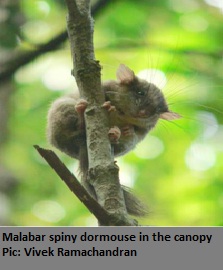Any and all opinions expressed in this newsletter are solely those of the author(s) and do not reflect the opinion of ATREE.
Centre for Excellence in Conservation Science
Royal Enclave,Srirampura,Jakkur Post
Bangalore-560064
Telephone: 080-23635555 (EPABX)
Fax : 080- 23530070
The forests of Kakachi are a heterogeneous
and complex habitat matrix. There are
primary forests with towering giants,
secondary regenerating patches that
resemble montane sholas and regions with
only the economically important canopy trees
removed. Patterns of vertical stratification
and canopy utilization by non-volant small
mammals were analysed across this habitat.
In all, eight species were recorded of which
three were mainly or exclusively arboreal.
The community can be classified into three
groups in relation to their vertical activity.
Firstly, the terrestrial shrews, mice and rats, a
second group comprising scansorial species
of the genus Rattus that mainly use the
ground and under storey and lastly, an
arboreal group of squirrels and rodents.
Community composition and relative
abundance of species in the different vertical
strata were dissimilar, with a general
reduction of species in the upper layers.
Results indicate that structural changes in
rain forest habitat by selection-felling and
clear-felling change community composition
but they do not seem to alter greatly the
specific patterns of vertical habitat utilization.
The White-bellied wood rat dominated the
community at ground level across all habitats
and malabar spiny dormouse was most often
found in the canopy. These two species are
important seed predators and this differential
habitat utilization could be a mechanism to
avoid competition. Unlike the Neo-tropics
and the Orient, the rainforests of the Western
Ghats are similar to the African wet forests in
being species poor for non-volant small
mammals, which maybe due to geographic
isolation and historic habitat disturbance and
fragmentation.
Editorial Team
Editor: Allwin Jesudasan
Associate editor: Rajkamal Goswami
Editorial Review: R. Ganesan, M. Soubadra Devy, T. Ganesh
Design and presentation: Kiran Salegame
A S H O K A T R U S T F O R R E S E A R C H I N E C O L O G Y A N D T H E E
N V I R O N M E N T
Small mammals of the rainforest
- Vivek Ramachandran
If you have any suggestions or comments please let us know through the boxes below






